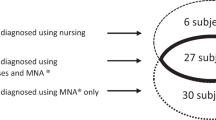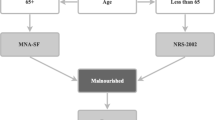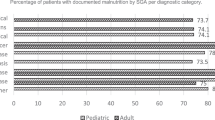Abstract
Background and objective:
Malnutrition is a common and underrecognized clinical problem among aged institutionalized patients. The aim of this study was to investigate how well nurses recognize malnutrition in elderly patients in long-term care hospitals in Helsinki.
Subjects and methods:
In this descriptive, cross-sectional study, the nutritional status of 1043 elderly patients was assessed with the Mini Nutritional Assessment (MNA), their body mass indices (BMIs) (kg m−2) were counted, and factors related to their nutritional care were queried using a structured questionnaire. In addition, we asked the opinions of 53 nurses on whether they considered their patients to suffer from malnutrition. All the long-term care hospitals in Helsinki, Finland participated in this study.
Results:
The mean age of the patients was 81 years. The nurses considered only 15.2% of the patients to be malnourished, although the MNA showed that 56.7% were malnourished (MNA<17 points). Those recognized as malnourished were truly anorectic, with a mean BMI of 17.2. Of those patients having a BMI<20 and MNA<17, the nurses considered only one-third to be malnourished. Of those having a BMI>24 but MNA<17, only 2% were recognized as having malnutrition. Even those patients considered to be malnourished received snacks and nutritional supplements less than the patients that the nurses considered to have normal nutritional status. However, only one in six of the malnourished patients received oral nutritional supplements.
Conclusions:
The nurses recognized malnutrition in their aged patients poorly. Nutrition education for nurses is urgently needed, as malnutrition and weight loss have been considered significant problems, and the benefits of nutritional care are well established.
This is a preview of subscription content, access via your institution
Access options
Subscribe to this journal
Receive 12 print issues and online access
$259.00 per year
only $21.58 per issue
Buy this article
- Purchase on Springer Link
- Instant access to full article PDF
Prices may be subject to local taxes which are calculated during checkout

Similar content being viewed by others
References
Akner G, Cederholm T (2001). Treatment of protein-energy malnutrition in chronic nonmalignant disorders. Am J Clin Nutr 74, 6–24.
Beck AM, Ovesen L (1998). At which body mass index and degree of weight loss should hospitalized elderly patients be considered at nutritional risk? Clin Nutr 17, 195–198.
Bleda MJ, Bolibar I, Pares R, Salva A (2002). Reliability of the Mini Nutritional Assessment (MNA) in institutionalized elderly people. J Nutr Health Aging 6, 134–137.
Dey DK, Rothenberg E, Sundh V, Bosaeus I, Steen B (2001). Body mass index, weight change and mortality in the elderly. A 15 y longitudinal population study of 70 y olds. Eur J Clin Nutr 55, 482–492.
Edington J, Barnes R, Bryan F, Dupree E, Frost G, Hickson M et al. (2004). A prospective randomised controlled trial of nutritional supplementation in malnourished elderly in the community: clinical and health economic outcomes. Clin Nutr 23, 195–204.
Green SM, Watson R (2006). Nutritional screening and assessment tools for older adults: literature review. J Adv Nurs 54, 477–490.
Guigoz Y (2006). The Mini Nutritional Assessment (MNA) review of the literature—what does it tell us? J Nutr Health Aging 10, 466–485.
Guigoz Y, Lauque S, Vellas BJ (2002). Identifying the elderly at risk for malnutrition the Mini Nutritional Assessment. Clin Geriatr Med 18, 737–757.
Hickson M (2005). Malnutrition and ageing. Postgrad Med J 82, 2–8. Review.
Irving GF, Olsson BA, Cederholm T (1999). Nutritional and cognitive status in elderly subjects living in service flats, and the effect of nutrition education on personnel. Gerontology 45, 187–194.
Jones JM (2002). The methodology of nutritional screening and assessment tools. J Hum Nutr Dietet 15, 59–71.
Kelly IE, Tessier S, Cahill A, Morris SE, Crumley A, McLaughlin D et al. (2000). Still hungry in hospital: identifying malnutrition in acute hospital admissions. QJM 93, 93–98.
Kondrup J, Allison SP, Elia M, Vellas B, Plauth M, Educational clinical practice committee, european society of parenteral enteral nutrition (ESPEN) (2003). ESPEN guidelines for nutrition screening 2002. Clin Nutr 22, 415–421.
Kruizenga HM, Van Tulder MW, Seidell JC, Thijs A, Ader HJ, Van Bokhorst-de van der Schueren MA (2005). Effectiveness and cost-effectiveness of early screening and treatment of malnourished patients. Am J Clin Nutr 82, 1082–1089.
Landi F, Onder G, Gambassi G, Pedone C, Carbonin P, Bernabei R (2000). Body mass index and mortality among hospitalized patients. Arch Intern Med 60, 2641–2644.
McWhirter JP, Pennington CR (1994). Incidence and recognition of malnutrition in hospital. BMJ 308, 945–948.
Milne AC, Avenell A, Potter J (2006). Meta-analysis: protein and energy supplementation in older people. Ann Intern Med 144, 37–48.
Morley JE (2001). Anorexia, body composition, and aging. Curr Opin Clin Nutr Met Care 4, 9–13.
Mowe M, Bohmer T (1991). The prevalence of undiagnosed protein-calorie undernutrition in a population of hospitalized elderly patients. J Am Geriatr Soc 39, 1089–1092.
Mowe M, Bosaeus I, Rasmussen HH, Kondrup J, Unosson M, Irtun O (2006). Nutritional routines and attitudes among doctors and nurses in Scandinavia: a questionnaire based survey. Clin Nutr 25, 524–532.
Pokrywka HS, Koffler KH, Remsburg R, Bennett RG, Roth J, Tayback M et al. (1997). Accuracy of patient care staff in estimating and documenting meal intake of nursing home residents. J Am Geriatr Soc 45, 1223–1227.
Potter JM (2001). Oral supplements in the elderly. Curr Opin Clin Nutr Metab Care 4, 21–28.
Rasmussen HH, Kondrup J, Staun M, Ladefoged K, Lindorff K, Jorgensen LM et al. (2006). A method for implementation of nutritional therapy in hospitals. Clin Nutr 25, 515–523.
Riviere S, Gillette-Guyonnet S, Voisin T, Reynish E, Andrieu S, Lauque S et al. (2001). A nutritional education program could prevent weight loss and slow cognitive decline in Alzheimer's disease. J Nutr Health Aging 5, 295–299.
Roubenoff R (2004). Sarcopenic obesity: the confluence of two epidemics. Obes Res 12, 887–888.
Saletti A, Lindgren EY, Johansson L, Cederholm T (2000). Nutritional status according to Mini Nutritional Assessment in an institutionalized elderly population in Sweden. Gerontology 46, 139–145.
Sergi G, Perissinotto E, Pisent C, Buja A, Maggi S, Coin A et al. (2005). An adequate threshold for body mass index to detect underweight condition in elderly persons: the Italian longitudinal study on aging (ILSA). J Gerontol A Biol Sci Med Sci 60, 866–871.
Suominen M, Muurinen S, Routasalo P, Soini H, Suur-Uski I, Peiponen A et al. (2005). Malnutrition and associated factors among aged residents in all nursing homes in Helsinki. Eur J Clin Nutr 59, 578–583.
Suominen MH, Kivisto SM, Pitkala KH (2007). The effects of nutrition education on professionals’ practice and on the nutrition of aged residents in dementia wards. Eur J Clin Nutr 61, 1226–1232.
Tayback M, Kumanyika S, Chee E (1990). Body weight as a risk factor in the elderly. Arch Intern Med 150, 1065–1072.
Vellas B, Villars H, Abellan G, Soto ME, Rolland Y, Guigoz Y et al. (2006). Overview of the MNA—its history and challenges. J Nutr Health Aging 10, 456–463.
Villareal DT, Banks M, Siener C, Sinacore DR, Klein S (2004). Physical frailty and body composition in obese elderly men and women. Obes Res 12, 913–920.
Young KW, Greenwood CE, van Reekum R, Binns MA (2004). Providing nutrition supplements to institutionalized seniors with probable Alzheimer's disease is least beneficial to those with low body weight status. J Am Geriatr Soc 52, 1305–1312.
Acknowledgements
This study is part of a larger study that the City of Helsinki has organized in order to develop the nutritional care of elderly patients. Many thanks go to the personnel in the hospitals for their cooperation during the study.
Author information
Authors and Affiliations
Corresponding author
Rights and permissions
About this article
Cite this article
Suominen, M., Sandelin, E., Soini, H. et al. How well do nurses recognize malnutrition in elderly patients?. Eur J Clin Nutr 63, 292–296 (2009). https://doi.org/10.1038/sj.ejcn.1602916
Received:
Revised:
Accepted:
Published:
Issue Date:
DOI: https://doi.org/10.1038/sj.ejcn.1602916
Keywords
This article is cited by
-
Change in Prescribing for Secondary Prevention of Stroke and Coronary Heart Disease in Finnish Nursing Homes and Assisted Living Facilities
Drugs & Aging (2019)
-
Registered nurses’ and older people’s experiences of participation in nutritional care in nursing homes: a descriptive qualitative study
BMC Nursing (2018)
-
Malnutrition in hospitalised older adults: A multicentre observational study of prevalence, associations and outcomes
The Journal of nutrition, health and aging (2017)
-
Management of malnutrition in geriatric trauma patients: results of a nationwide survey
European Journal of Trauma and Emergency Surgery (2016)
-
Nutrition and psychological well-being among long-term care residents with dementia
The Journal of nutrition, health and aging (2015)



